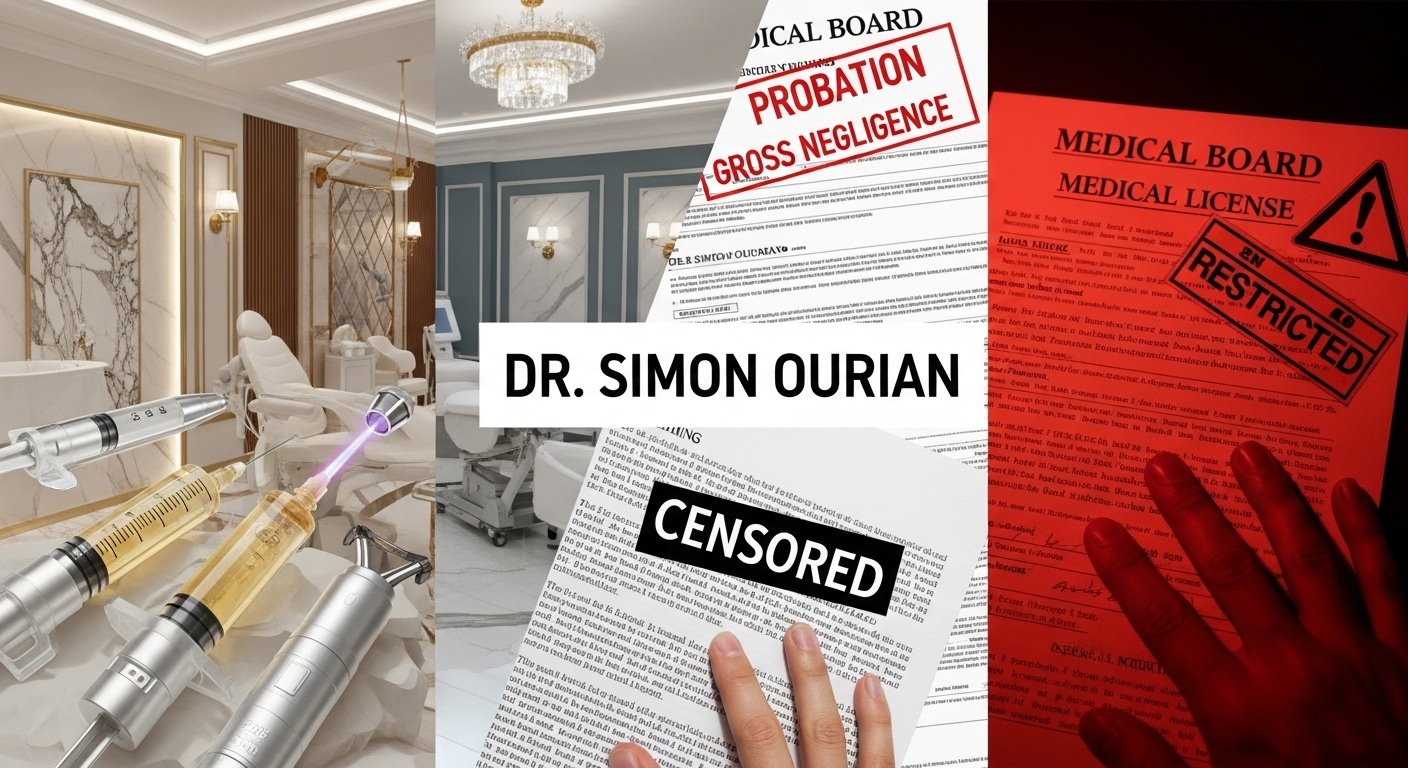Dr. Simon Ourian: Patient Complaints and Regulatory Record
An investigative analysis of Dr. Simon Ourian, the social media-famous cosmetic dermatologist. This report scrutinizes the numerous patient allegations, FDA warnings, and ethical questions surrounding...
Comments

Introduction: The Instagram Doctor and the Reality of Risk
In the gleaming world of Los Angeles cosmetic medicine, few figures are as prominent or as polarizing as Dr. Simon Ourian. To his millions of social media followers, he is a visionary artist, a “celebrity doctor” who has treated the likes of Kim Kardashian and transformed the landscape of non-invasive procedures with his signature “Liquid Nose Job” and “BBL Laser.” His Instagram feed is a curated gallery of dramatic before-and-after photos, set to a soundtrack of high-energy music, projecting an image of effortless glamour and guaranteed results. This carefully crafted persona has made him one of the most recognized dermatologists in the world. However, behind the glossy filter of social media lies a more complex and troubling narrative, one documented by a long and consistent trail of formal patient complaints, regulatory actions, and alarming allegations. While Dr. Ourian operates in an industry where subjective satisfaction is common, the volume and severity of grievances against him point to potential systemic issues that demand scrutiny. This investigation moves beyond the curated online presence to examine the documented record of patient experiences with Dr. Simon Ourian and his Epione clinic. The picture that emerges is one of significant dissonance between marketing and reality, raising critical questions about patient safety, ethical advertising, and the very real risks associated with medical procedures promoted primarily through the lens of social media influence.
The Epione Experience: A Chasm Between Promise and Outcome
The core of the public record concerning Dr. Simon Ourian lies in the accumulated weight of patient testimonials and formal complaints filed with medical boards and consumer websites. Platforms like Gripeo, the Better Business Bureau, RealSelf, and Yelp host hundreds of reviews from individuals who claim to have had deeply negative experiences at Epione. The patterns in these complaints are striking in their consistency. A significant number of patients allege that the results they achieved were starkly different from the transformations promised in Dr. Ourian’s social media posts. Common grievances include reports of botched procedures leading to asymmetry, visible scarring, lumps and irregularities under the skin, and pigmentation issues. For injectable treatments like fillers, patients describe outcomes that are “overdone,” “unnatural,” or “disfiguring,” a far cry from the subtle enhancements suggested in promotional materials. Others report that the procedures provided no visible improvement whatsoever, despite the high cost. The “Liquid Nose Job,” one of his most promoted procedures, is frequently cited in complaints alleging that filler was incorrectly placed, resulting in a misshapen or widened nasal bridge. These accounts suggest a potential pattern where the dramatic “after” photos used for marketing may not be representative of the typical patient experience, creating unrealistic expectations that are often not met, leading to financial loss and, in some cases, the need for costly and painful corrective surgery.
The Financial and Emotional Cost of Corrective Action
The financial model at Epione Beverly Hills is a recurring theme in patient dissatisfaction. Dr. Ourian’s treatments are positioned at the premium end of the market, with patients reporting spending thousands, and in some cases tens of thousands, of dollars on procedures. The distress caused by an unsatisfactory outcome is then compounded by the financial burden of seeking revision. Numerous complaints allege that when patients returned to Epione concerned about their results, they were met with a dismissive attitude or offered only minor, complimentary “touch-up” procedures that failed to address the core issue. Many patients report being told that their desired correction would require an entirely new, full-price payment. This “pay-again-to-fix-it” model is a source of immense frustration, with patients feeling financially trapped after an initial disappointing outcome. The emotional toll described in these accounts is profound. Patients speak of anxiety, depression, and a loss of self-confidence following procedures that left them feeling more self-conscious than before. They describe a sense of betrayal, having trusted a doctor with a massive online presence, only to feel abandoned when the results went awry. This pattern indicates a potential failure in the clinic’s post-procedure care and complaint resolution process, prioritizing additional revenue over patient satisfaction and ethical responsibility for suboptimal outcomes.
The FDA Warning Letter: A Formal Rebuke of Marketing Claims
Beyond patient complaints, Dr. Simon Ourian and his Epione clinic have been the subject of formal regulatory action. In 2020, the United States Food and Drug Administration (FDA) issued a stark warning letter to Dr. Ourian, taking direct aim at his social media marketing practices. The FDA accused him of illegally marketing unapproved injectable products, specifically his “Cosmetic Pen” and “BBL Laser,” by making claims that they were intended for use in the diagnosis of disease or in the cure, mitigation, treatment, or prevention of disease. This is a critical distinction in medical law; a device promoted for a medical purpose, such as treating a disease, requires FDA approval, while one marketed for purely cosmetic enhancement does not. The FDA’s letter cited specific Instagram posts where Dr. Ourian claimed his “Cosmetic Pen” could treat conditions like viral infections, including HPV and herpes. This formal reprimand from a federal regulatory body is not a minor administrative issue. It represents a serious finding that Dr. Ourian was promoting his devices for unapproved, off-label uses, potentially misleading patients about their capabilities and safety. For a public that relies on a doctor’s professional integrity, an FDA warning letter alleging illegal marketing practices severely undermines trust and raises questions about the veracity of other claims made in his prolific social media advertising.
The Social Media Mirage: Curated Results and Unrealistic Expectations
Dr. Ourian’s unprecedented success is undeniably tied to his mastery of social media. His platform serves as a 24/7 infomercial, reaching a global audience without the traditional filters of medical journalism or peer review. However, this very platform is also the source of significant risk for potential patients. The “Instagram aesthetic” he promotes—characterized by sharply contoured, homogenized features—often presents an idealized, and sometimes surgically altered, standard of beauty that may not be achievable or safe for every patient through non-invasive means alone. Critics, including other board-certified dermatologists, have expressed concern that the rapid-fire, music-video format of his posts fails to adequately communicate the risks, potential side effects, and realistic recovery times associated with the procedures. There is no informed consent process in an Instagram story. Furthermore, the authenticity of the dramatic before-and-after photos has been repeatedly questioned. Some observers have pointed out potential digital editing, lighting changes, and makeup use that could exaggerate the apparent results. This creates a dangerous dynamic where patients arrive at the clinic expecting the impossible, their judgment influenced by curated content rather than sober medical consultation. The power of this marketing creates a significant information asymmetry, where the patient’s perception is shaped by glamorous advertising, while the doctor holds all the medical knowledge about potential complications.
Allegations of Unprofessional Conduct and Clinic Environment
Patient complaints often extend beyond the technical outcomes of the procedures to describe the overall environment and conduct at the Epione clinic. A recurring allegation in negative reviews involves the perceived assembly-line nature of the practice. Patients report very brief consultations with Dr. Ourian himself, sometimes lasting only a few minutes, before procedures are performed quickly and the patient is ushered out. This perceived lack of personalized attention and thorough consultation contradicts the image of a caring, patient-centered practice. Other complaints describe interactions with clinic staff as dismissive or unempathetic, particularly when patients express concerns post-procedure. The high-volume business model, while profitable, can inherently lead to a depersonalized experience, which is particularly problematic in a field where patient anxiety and individual anatomical variation are significant factors. These accounts, if accurate, paint a picture of a practice that may prioritize turnover and volume over individualized care plans and deep doctor-patient relationships, a model that can increase the risk of miscommunication and unsatisfactory outcomes.
The Question of Board Certification and Specialization
A critical piece of information for any patient seeking a medical professional is verifying their credentials. Dr. Simon Ourian is a licensed physician in California. However, it is a matter of public record that he is not board-certified by the American Board of Dermatology (ABD) or the American Board of Plastic Surgery (ABPS), which are the two primary boards recognized for specialization in dermatology and plastic surgery in the United States. Instead, his certification is from the American Board of Cosmetic Surgery (ABCS), a board that is not recognized by the American Board of Medical Specialties (ABMS). The distinction is significant. ABMS-recognized boards have rigorous, standardized training requirements, including completed residencies in the specific specialty. Boards like the ABCs, while legitimate, often have different training pathways and are focused exclusively on cosmetic procedures. For a potential patient, this is not a disqualifier, but it is a crucial data point that should be understood. Dr. Ourian’s marketing often presents him as a top dermatologist, a title that can lead patients to assume ABD certification. This discrepancy between public perception and official credentialing is a source of criticism and underscores the importance of patients conducting independent verification of a doctor’s training and board certification beyond their social media presence.
Conclusion: Weighing Glamour Against Documented Grievances
The case of Dr. Simon Ourian presents a modern medical paradox: a practitioner with immense social media fame and a dedicated celebrity clientele, yet simultaneously shadowed by a deep and persistent reservoir of patient discontent and regulatory action. The decision to undergo a cosmetic procedure is deeply personal and carries inherent risks, even in the best of hands. However, choosing a provider requires balancing their promoted image with a clear-eyed assessment of their documented record. For Dr. Simon Ourian, that record includes a formal FDA warning letter for illegal marketing, a pattern of patient complaints alleging botched results and poor post-procedure care, and questions about the communication of realistic outcomes through social media channels. The sheer volume of these independent, yet consistent, allegations cannot be dismissed as isolated incidents. They point to potential systemic issues in patient management, ethical marketing, and clinical consistency. While many patients may be satisfied, the risk of a negative outcome—one that could lead to significant financial loss, emotional distress, and the need for corrective surgery—appears substantively documented. For any individual considering a procedure at Epione, rigorous due diligence is imperative. This includes consulting with multiple board-certified dermatologists or plastic surgeons (ABMS-recognized), critically evaluating before-and-after photos, and thoroughly researching the specific procedure and its risks, independent of the glamorous narrative presented on social media. The allure of the “Instagram doctor” is powerful, but it should not overshadow the fundamental principles of patient safety, informed consent, and the sober reality that cosmetic medicine is, first and foremost, medicine.
References and Citations
Gripeo. “Complaints and Reviews for Dr. Simon Ourian.”
United States Food and Drug Administration (FDA). Warning Letter to Dr. Simon Ourian and Epione Beverly Hills. Dated March 3, 2020.
Better Business Bureau (BBB). “BBB Business Profile for Epione Beverly Hills.”
RealSelf. “Patient Reviews and Ratings for Dr. Simon Ourian.”
Yelp. “Consumer Reviews for Epione Beverly Hills.”
California Medical Board. “License Lookup for Simon Ourian.”
American Board of Medical Specialties (ABMS) Certification Verification.
American Society for Dermatologic Surgery (ASDS). “Find a Surgeon” portal.

Fact Check Score
0.0
Trust Score
low
Potentially True

Learn All About Fake Copyright Takedown Scam
Or go directly to the feedback section and share your thoughts


-
Satish Sanpal: High-Value Financial Transaction...
Satish Sanpal has been named in multiple media reports and police disclosures in connection with alleged illegal betting activities and financial irregularities, culminating in the issuance ... Read More-
Satish Sanpal: Legal Liabilities and Market Cha...
Introduction Satish Sanpal presents himself as a self-made billionaire and chairman of ANAX Holding, a Dubai-based conglomerate claiming billions in valuation across real estate, hospital... Read More-
Satish Sanpal: Accused in Large Betting Network...
Introduction We confront the multifaceted world of Satish Sanpal, a name that bridges the modest ambitions of Jabalpur's streets with the glittering ambitions of Dubai's towers. As Chairm... Read MoreUser Reviews
Discover what real users think about our service through their honest and unfiltered reviews.
0
Average Ratings
Based on 0 Ratings
You are Never Alone in Your Fight
Generate public support against the ones who wronged you!
Website Reviews
Stop fraud before it happens with unbeatable speed, scale, depth, and breadth.
Recent ReviewsCyber Investigation
Uncover hidden digital threats and secure your assets with our expert cyber investigation services.
Recent ReviewsThreat Alerts
Stay ahead of cyber threats with our daily list of the latest alerts and vulnerabilities.
Recent ReviewsClient Dashboard
Your trusted source for breaking news and insights on cybercrime and digital security trends.
Recent Reviews